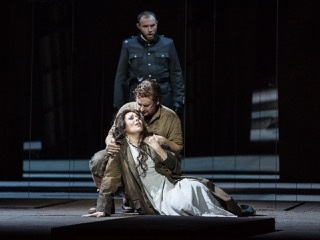 Italy Verdi, Il trovatore: Chorus and Orchestra of Teatro dell ‘Opera, Rome. Chorus Master, Roberto Gabbiani / Jader Bignamini (conductor). Teatro dell ‘Opera Rome 2.3.2017. (JB)
Italy Verdi, Il trovatore: Chorus and Orchestra of Teatro dell ‘Opera, Rome. Chorus Master, Roberto Gabbiani / Jader Bignamini (conductor). Teatro dell ‘Opera Rome 2.3.2017. (JB)

Cast:
Conte di Luna – Simone Piazzola
Leonora – Tatiana Serjan
Azucena – Ekaterina Semenchuk
Manrico – Stefano Secco
Production:
Production – Alex Ollé with La Fura dels Baus
Sets – Alfons Flores
Costumes – Lluc Castells
Lighting – Urs Schönenbuam
The parodists usually begin their plot summary with This is the story of Il trovatore. And sure enough, there is an abundance of barmy stuff here, not to mention incomprehensible action. The incomprehension is due to most of the action having taken place before the curtain goes up on the first act. And barmy land reigns freely as elements of the aforesaid, unseen action, fall over one another with breath-taking speed.
But that is to take in only the superficialities. And no, I’m not about to make an apology for the nineteenth-century’s love affair with melodrama. Why? Because all the evidence tells me that during the twentieth century and into our own, that love affair has gained rather than weakened in strength. Verdi’s contribution to this is a major factor in his and its success. The plot may be barmy but the relationships of the characters are not. That is what today’s (and yesterday’s) audiences empathise with. And in no other Verdi opera did the music pour out of the maestro with such white-hot inspiration. He wrote the whole opera in the space of a month! If you don’t hear this in the music, you will certainly feel it; in the melodies, the ensembles, the orchestrations, the harmonies, the accelerations and the rallentandos. Even the deaf will be convinced that this music wrote itself. Verdi would never quite repeat this total accomplishment, though he would often come close.
We tell ourselves stories all the time. Verdi too. But Verdi’s stories are in music, not words. He conveys a situation, a character, a danger, a rejoicing, an uncertainty and the rest, through the intensity or nonchalance (sometimes both at once) of a chord, a harmonic progression, a timbre of voice or instrument, an increase or slowing of pace, which often lasts mere seconds. These mini-second stories pile on top of one another. (This happens in real life where our experience of simultaneous, conflicting stories also creates confusions.) Verdi, more than any other composer, has taught us how to enjoy confusions.
I was much taken by Jader Bignamini’s taught rhythms in his conducting of this melodrama. A leading orchestral player didn’t agree with me: Verdi makes more musical sense with a bit more flexibility, he said. But I stay with my own ears here; the strict tightness makes an excellent bedfellow for the melodrama. This was so musically theatrical that it didn’t to me or other critics sound at all inflexible.
The staging by Alex Ollé and his La Fura dels Baus (in coproduction with the Amsterdam Opera and the Opéra National of Paris) had all the dignity and impressive geometry (sets by Alfons Flores) and restrained colours (costumes in greys, black and whites by Lluc Castells) that we have come to expect from this inventive company. Special mention should be made of the white costumes of the nun’s chorus, hauntingly lit like ghost spectres. In the opening scenes, I found the hints of the first World War trenches surprisingly apt, but as the show went on, that invention wore a little thin. To his credit, Ollé and his team never forgot that episodes from four separate narrative strands (built round the stories of the four main characters) keep colliding and falling over one another, all much helped by Urs Schönenbaum’s suggestive lighting.
Verdi engages audience empathy for the villain as well as the three heroes. Simone Piazzola has thoroughly understood this ambiguity of the Count di Luna. His voice is rich, warm and mellifluous, with a fine legato line in both arias. His voice is not so well projected as the other three principals and he did get somewhat marginalised in the ensembles, though he made up for everything in those two great solos.
Stefano Secco (Manrico) has rather a smaller voice than we are used to hearing in this role, but he makes up for everything in the musicality of his delivery, the excellence of his diction and the meaning he pours into every word of the text: a first-rate singer-actor. If you were expecting a del Monaco or a Pavarotti ‘Di quella pira’, belted out with vocal assurance, you would have been disappointed. But elsewhere, Secco was superior to the Great Luciano, in characterisation, phrasing and musicianship.
The two women were even better. Ekaterina Semenchuk has an enviable palette of vocal colours for Azucena with beautiful low notes as well as dramatic high-ones (these last never overdone as they often were in some singers of the past); Semenchuk brings subtleties to this role of both dynamics and phrasing, demonstrating a unique musical intelligence in the part. She was the audience’s favourite of the four and I respect their vote (judged from the decibels of applause).
But my own vote for the finest vocal performance goes to Tatiana Serjan’s Leonora. Both Semenchuk and Serjan have some difficulties still with the Italian language. But for all that, Serjan got under the skin (or should that be inside the skin?) of Leonora, not just in her two great arias, but just as impressively in the ensembles. It helped that (beauty of voice aside –and fine as the voice is, she is not Caballé, because no one can ever match that lady in this role) Serjan is also gloriously involved in the storytelling.
Further performances of this inspired Trovatore on March 4, 5*, 7. 8*, 10 (those marked * with another cast).
Jack Buckley